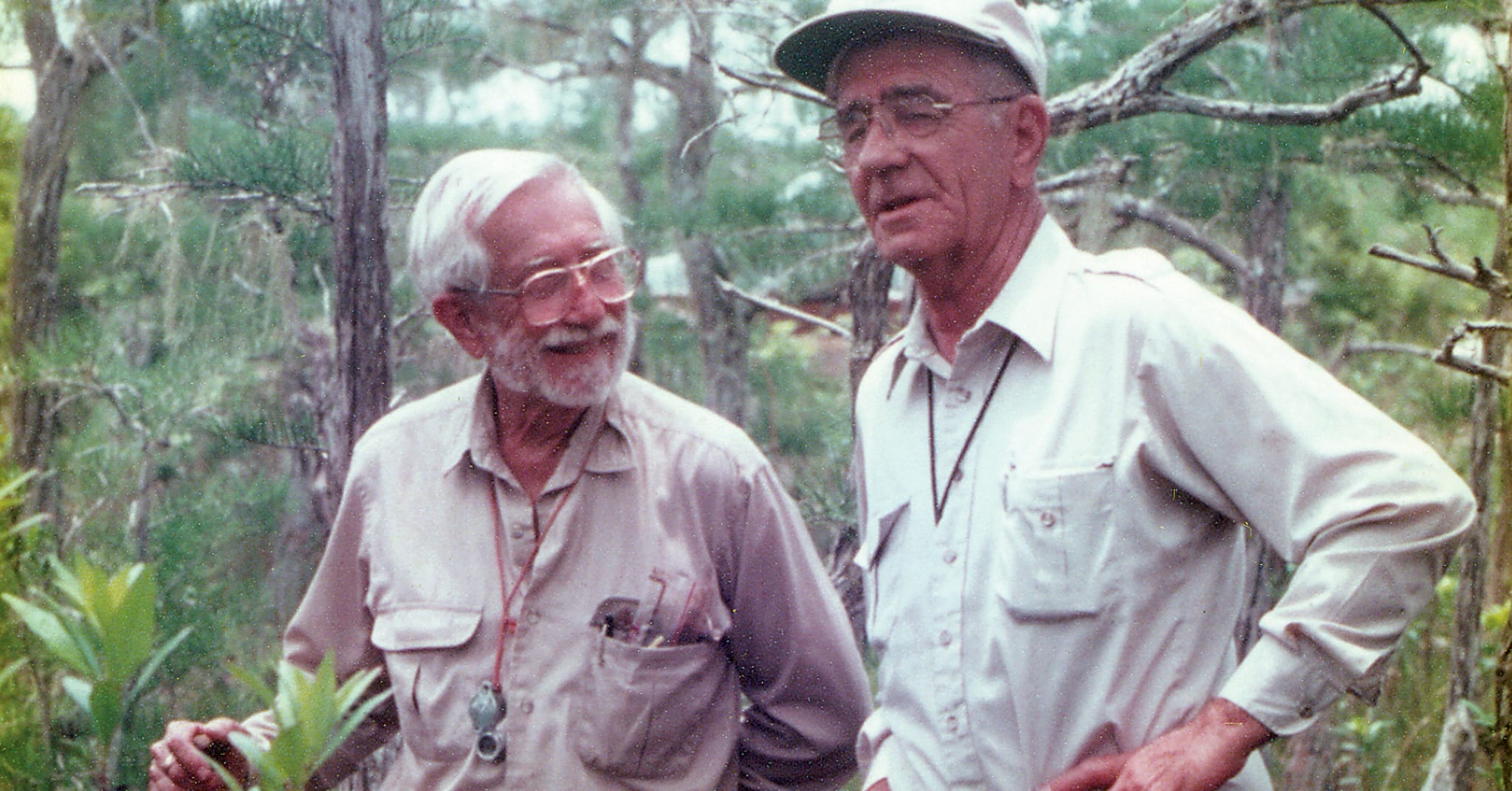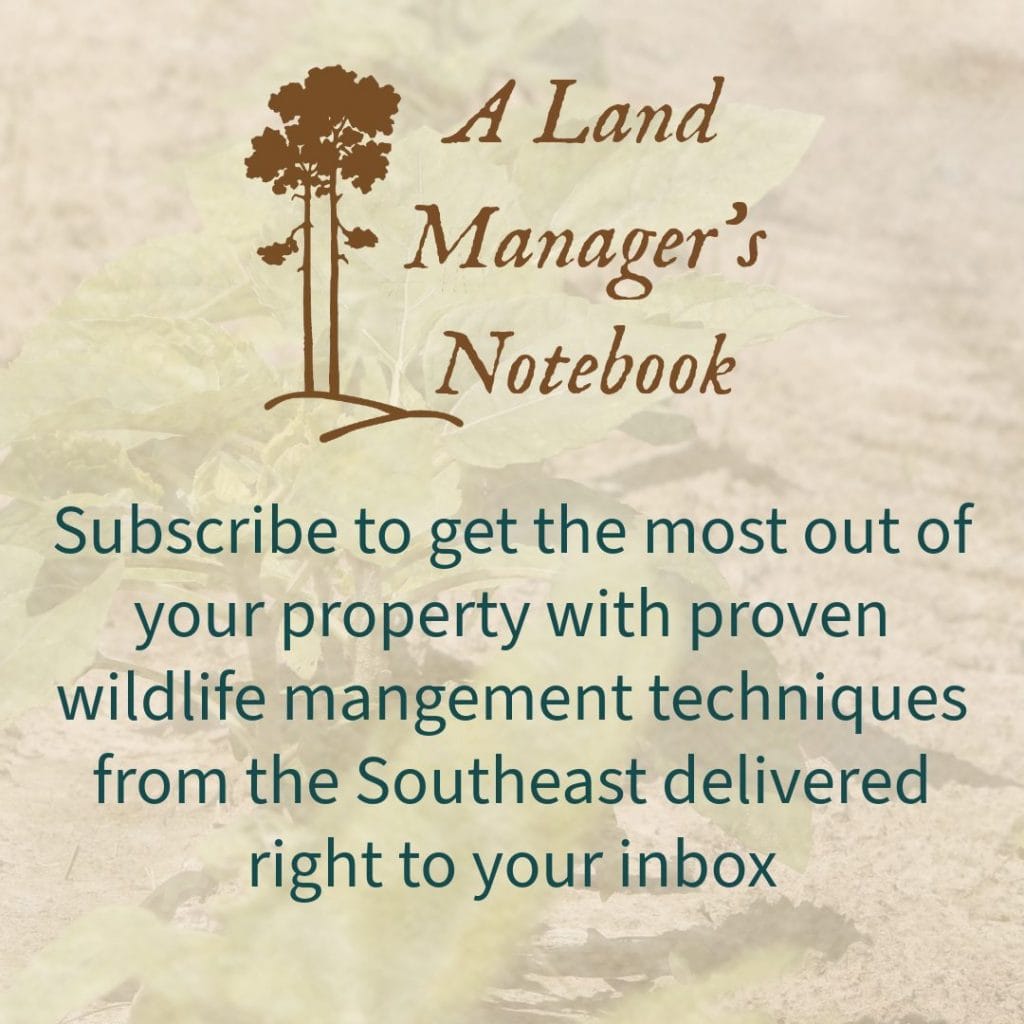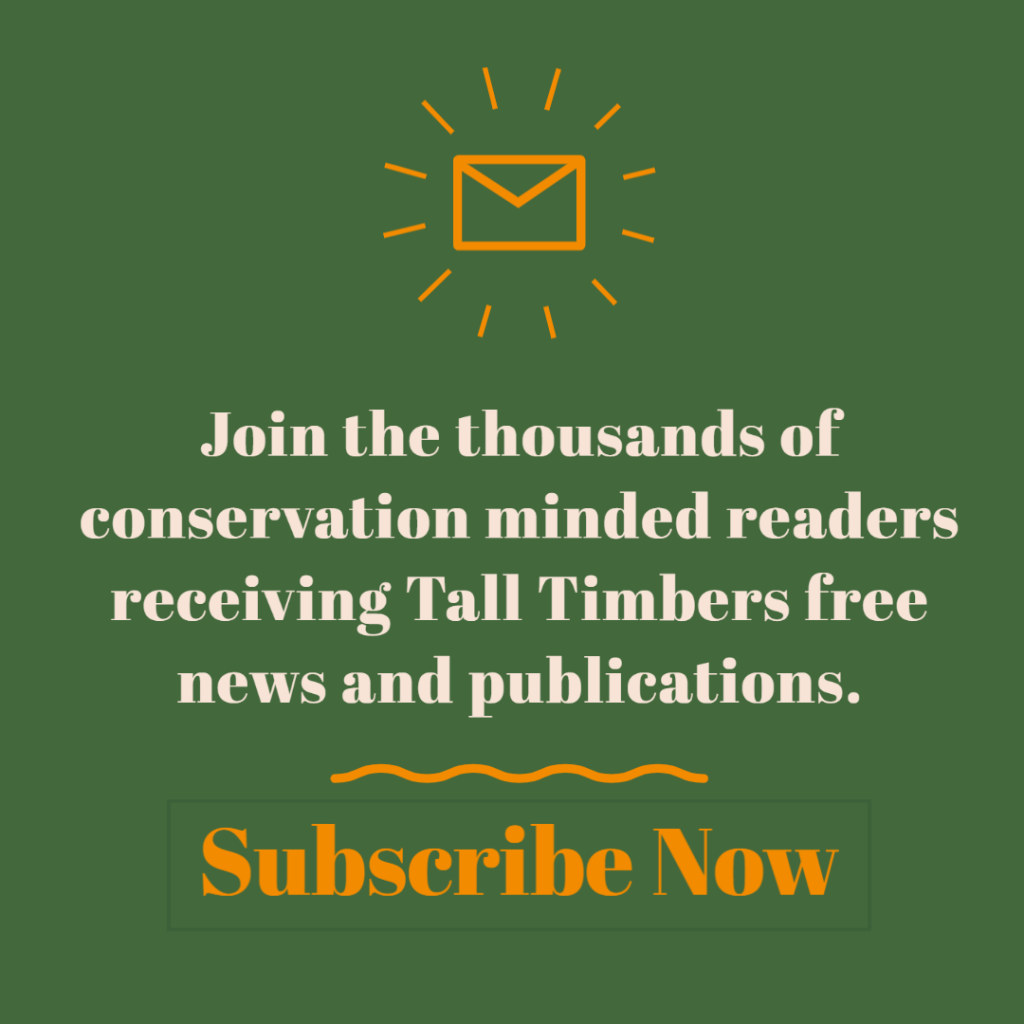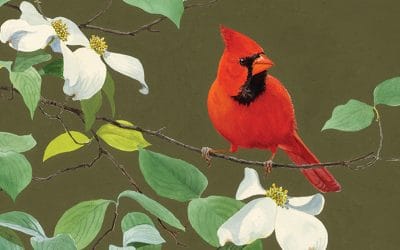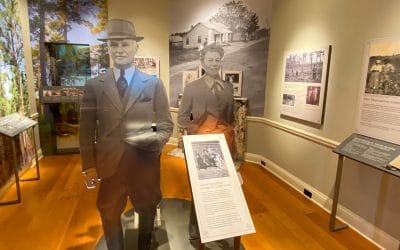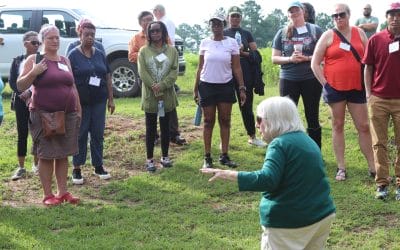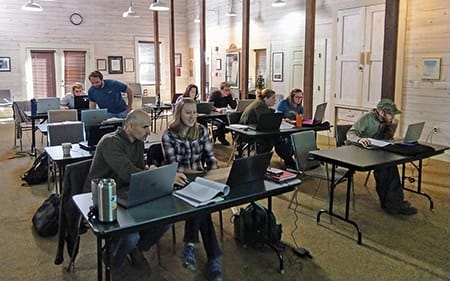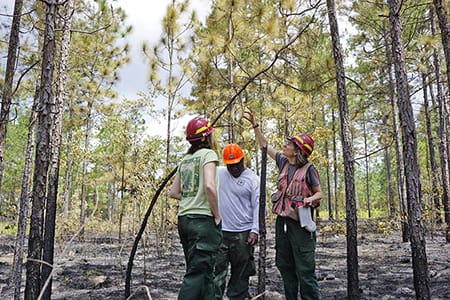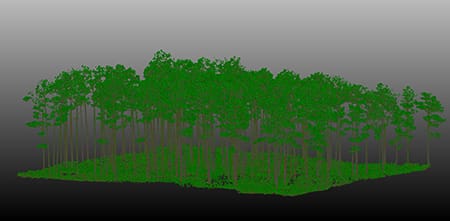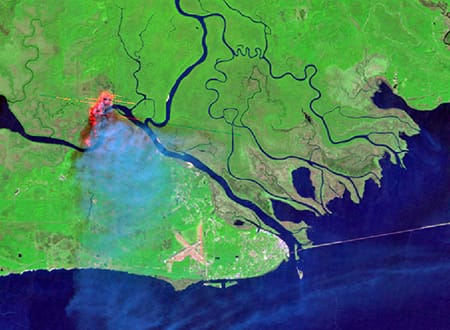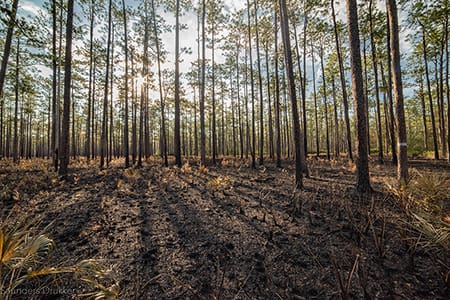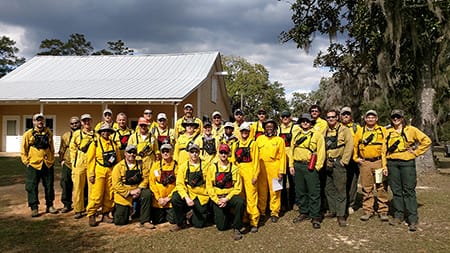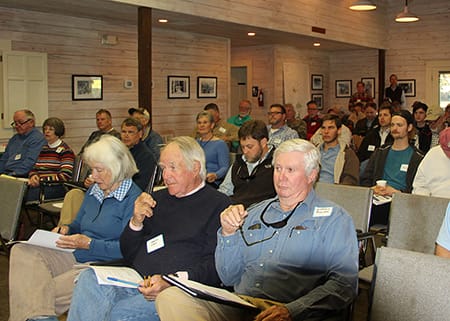The Many Contributions of Tall Timbers’ Beadel Fellows
In the history book about Tall Timbers, The Legacy of a Red Hills Hunting Plantation, coauthor Robert L. Crawford states, “Beadel Fellows have contributed immeasurably to research at Tall Timbers throughout the years. They provide wisdom and a storehouse of knowledge for station researchers.”
What are the Beadel Fellowships?
Tall Timbers Beadel Fellowships are awarded from one to three years to researchers for a specific project related to the organization’s mission. Beadel Fellows are provided a stipend that is funded by bequests to Tall Timbers Research, Inc. from benefactor Henry Beadel and his brother Gerald when the organization was founded. Fellowships can continue beyond the initial award.
Nominees for the fellowships are recommended by Tall Timbers research staff and must be approved by the Science and Land Management Committee and the Board of Trustees. They are often retired academics who are still active in their field of research. Beadel Fellows are evaluated annually when they provide a written report on their project. Tall Timbers has benefited greatly from the interactions Beadel Fellows have with staff and the contributions they have made to our research mission.
Dr. Gordon E. Gates (Earthworms 1967-1975) and Dr. Andre F. Clewell (Botany 1967-1976) were the first researchers awarded Beadel Fellows. A distinguished list of fellows followed them, some for only a few years, but others like Dr. Henry M. Stevenson (Ornithology 1971-1991), Dr. Robert K. Godfrey, (Botany 1972-2000), Dr. William Brueckheimer (History 1973-1990), and Angus Golson (Botany 1994-2007) had long tenures. Their work is described here.
An Authority on the Bird Distribution for Florida
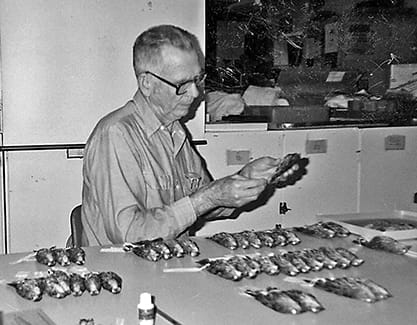
Henry Stevenson working at Tall Timbers. Photo by Bruce Anderson, Tall Timbers Archives.
Dr. Henry Stevenson was considered the foremost authority on Florida’s birds. Before he retired from the faculty at Florida State University in 1975, Stevenson was awarded a Beadel Fellowship that allowed him to continue his research on the distribution of birds in the southeastern U.S., especially in Florida and the Big Bend region.
During his tenure as a Beadel Fellow, Dr. Stevenson worked on The Birdlife of Florida, which was published posthumously in 1994 by University Press of Florida. Publicity for the book states, “For the last six years of his life, Stevenson worked with coauthor Bruce Anderson to complete this incomparable legacy, a reference of 665 detailed species accounts of all the state’s avifauna, including the exotics. For each of the species accounts, Birdlife contains sections on world distribution and Florida status and, if appropriate, migration, breeding, Christmas Bird Count data, and haunts and habits. Other sections in some accounts include problems of identification, adverse factors, and variations (subspecies).” This 907-page book, is considered the authority on bird distribution for Florida.
Tall Timbers history author Robert Crawford wrote that Stevenson’s Beadel Fellowship provided funds to work on his book, an office at Tall Timbers in the current archives building, and also allowed him to travel to museums to examine Florida specimens. It was in his office at Tall Timbers that Stevenson suffered a fatal heart attack in 1991, after the Birdlife manuscript was completed, but before it was published.
In the history, Crawford states Henry Stevenson and Herbert Stoddard were research colleagues and that they shared an interest in the occurence of local birds. Stoddard’s WCTV TV tower project provided an abundance of bird specimens for Stevenson to examine. The dedication page in The Birdlife of Florida states, “This book is dedicated to the memory of Herbert L. Stoddard, Sr. (1889-1970) whose contributions established an early foundation for Florida ecology and ornithology.”
A Collaboration and Close Friendship
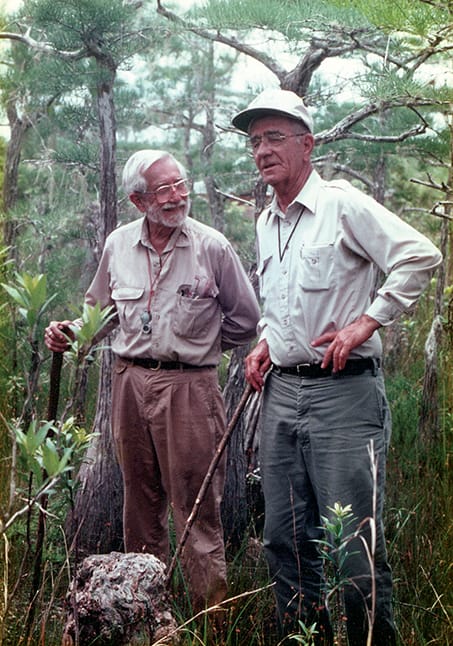
Robert Godfrey and Angus Gholson, ca. 1990. Photo by Sharon Hermann, Tall Timbers Archives.
Beadel Fellows Dr. Robert Godfrey, affectionately called “Dr. Bob,” and Angus Golson were good friends who often botanized together. They “shared a love and concern for the dwindling natural areas in their region….” The two came from different professional backgrounds. Bob Godfrey was a retired botany professor from Florida State University, who had curated the university’s herbarium, now named in his honor, and was the coauthor of several books on plants including the standard regional reference, Trees of Northern Florida. In 1988, Godfrey published Trees, Shrubs, and Woody Vines of Northern Florida and Adjacent Georgia and Alabama, which is dedicated to Angus Kemp Gholson, Jr. “Not to pay a debt but to acknowledge it.” In the preface to the book, Golson also acknowledged Tall Timbers and the Beadel Fellowship that sponsored the research for the book and provided him with staff and financial support including office space. Dr. Bob’s tenure as a Beadel Fellow continued until his death in 2000. It was the longest –28 years.
Angus Golson, had a forestry degree from the University of Florida, and was retired from the U.S. Army Corps of Engineers, where he began in 1953 as an assistant resource manager at their Jim Woodruff Dam near Chattahoochee, Florida and retired as its manager in 1983. A botanical survey was conducted before the impoundment of Lake Seminole and Golson was assigned to accompany Dr. Robert Thorne of Iowa State University during this effort. The experience gave Golson a passion for botany, especially when he met Bob Godfrey. They began botanizing together in north Florida, south Georgia and south Alabama, collecting plants and noting their locations. Both men had a species of Liatris (commonly called gayfeather or blazing star), named after them: Godfrey’s Blazing star, Liatris provincialis, found in sandhill habitat of Wakulla and Franklin Counties, and the rare Gholson’s Gayfeather, Liatris gholsonii, which can be found in the bluffs and ravines along the Apalachicola River. Also named for Gholson, is the Angus Gholson Nature Park and Nature Trail found in the heart of his hometown of Chattahoochee, Florida.
For a 2002 newspaper article about the then 81-year-old Gholson* titled “N. Florida is Gholson’s Garden,” environmental writer Craig Pittman interviewed another Chattahoochee, Florida native, the late Florida State University president Talbot “Sandy” D’Alemberte, who had known Gholson all his life. He stated, “Gholson was part of a dying breed, a citizen-scientist like Thomas Jefferson.”
The article ends with this quote from Gholson:
“Three things are very important: air, water and food,” Gholson says. “You can’t do without air but for just a damn few seconds. You can’t do without water or food for long, either. All of it comes from plants. I don’t know what we’re going to do when we cut them all down. We’re going to have to plow up some of these interstates and plant corn.”
*https://www.sun-sentinel.com/news/fl-xpm-2002-11-10-0211100129-story.html
A Survey of Leon County’s Hunting Plantations Led to Historical Research on Tall Timbers
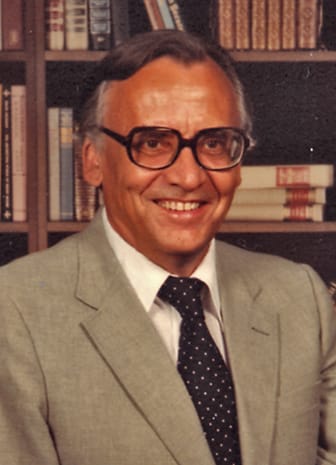
Dr. William R. Brueckheimer
Dr. William R. Brueckheimer, who had retired as chair of the geography department at Florida State University, was a coauthor of Leon County Hunting Plantations: An Historical and Architectural Survey published by the Historic Tallahassee Preservation Board. He had spent years researching the history and development of hunting plantations in the southeast, including the history of rural Leon County and its agriculture.
William Brueckheimer was Beadel Fellow from 1973-1990. During this time, he researched and wrote a manuscript about the history of Tall Timbers—an outcome of his research on the Red Hills quail preserves and their land-use practices. His chronical of Henry Beadel and Tall Timbers began with the physical setting of Tall Timbers Plantation and ended with the establishment of Tall Timbers Research Station in 1958. The manuscript had languished in the Tall Timbers’ library until author Robert Crawford was engaged to incorporate Brueckheimer’s work into a comprehensive history of Tall Timbers. It was the basis for part one of The Legacy of a Red Hills Hunting Plantation: Tall Timbers Research Station & Land Conservancy. Brueckheimer was given co-authorship as a result. He was very pleased to see that is years of work on the history of Tall Timbers was finally being used to publish The Legacy of a Red Hills Hunting Plantation by the University Press of Florida in 2012.
Beadel Fellows continue to enrich Tall Timbers with their research and knowledge. They detail their activities in reports to the director of research who in turn shares them with the Board Science and Land Management Committee. In the 2022 issue of the eJournal, current Beadel Fellow Dr. Jeff Glitzenstein writes about the work he and his wife and colleague, Dr. Donna Streng, are conducting to restore two rare plants to longleaf pine ecosystems sites in the southeast.
Originally published in the 2022 Tall Timbers eJournal.

